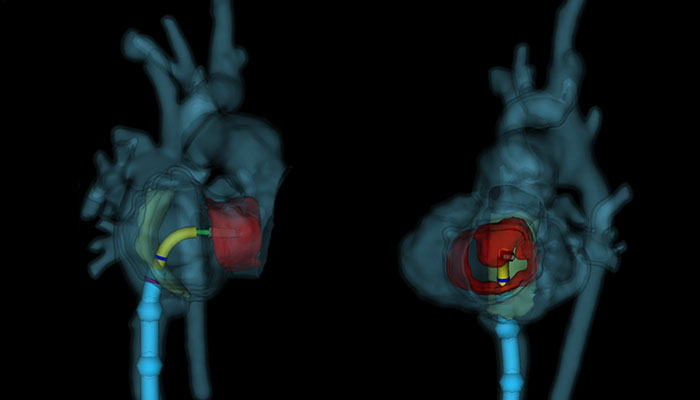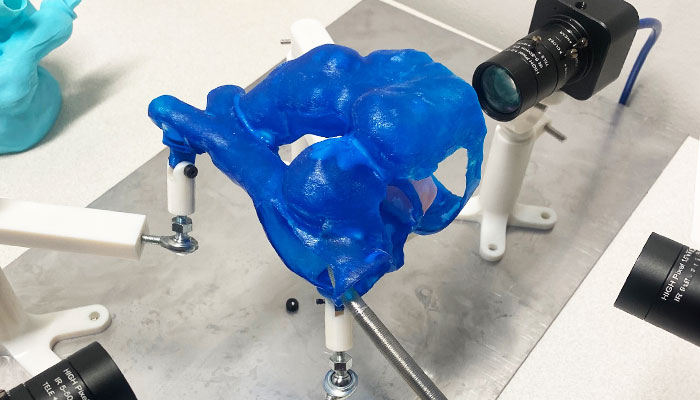HOW CAN WE HELP YOU? Call 1-800-TRY-CHOP
In This Section
Can High-risk for Surgery CHD Patients be Treated With Transcatheter Edge-to-edge Repair Instead?

Virtual, patient-specific model created for planning TEER procedure.
The findings:
Researchers at Children's Hospital of Philadelphia reported early results of successful protocolized efforts to introduce transcatheter edge-to-edge (TEER) repair of severe atrioventricular valve regurgitation (AVVR) into the congenital heart disease (CHD) population at CHOP.
To aid with the TEER procedure, the research team used a small, implanted clip device delivered via a catheter that attaches to the dysfunctional atrioventricular valve to help close it more completely and restore normal blood flow through the heart without need for open heart surgery.
The team described their initial experience with four pediatric patients in this population and established a standardized image‐based approach to patient screening and for TEER therapy in high surgical risk CHD patients at CHOP.
Why it matters:

Plastic model of patient-specific anatomy created for planning TEER procedure.
AVVR is a devastating complication in children and young adults with CHD, particularly in patients with single ventricle physiology, as it is associated with increased risk of mortality. TEER is a fast expanding, minimally invasive option for the treatment of AVVR in adults that avoids the morbidity and mortality associated with open heart surgery. However, the application of TEER in patients with CHD has been limited.
Who conducted the study:
Among the CHOP researchers was senior author Matthew J. Gillespie, MD, an attending cardiologist in the Cardiac Center, medical director of the Cardiac Catheterization Laboratory, and co-leader of Center for Pediatric Heart Valve Disorders Frontier Program, and first author Matthew Jolley, MD, an attending anesthesiologist with the Division of Cardiothoracic Anesthesiology and the Topolewski Endowed Chair in Pediatric Cardiology.
How they did it:

Intraprocedural X-ray image of TEER procedure in a patient with Fontan anatomy.
The research team developed a standardized screening and planning process for patients using cardiac magnetic resonance imaging, three-dimensional echocardiography, and both virtual and physical simulation. This allowed the team to conduct "procedure rehearsals" before treating the patients based on their unique anatomy.
All four patients had severe AVVR. Three patients required a Fontan operation, while one required a repair of a common atrioventricular canal defect. All were considered at prohibitively high risk for surgical repair.
In the four cases, following the protocol allowed each patient to undergo the TEER procedure with the MitraClip™ G4 clip delivery system to successfully place the clip(s) in the intended location, and to avoid open heart surgery. Patients were clinically followed post-intervention.
Quick thoughts:

Matthew J. Gillespie, MD
"I'm confident in our ability to screen these patients and our technical ability to get these cases done safely," Dr. Gillespie said. "Our long-term goal is to build on this early experience and to facilitate the adaptation of TEER and other catheter‐based valve therapies in CHD patients suffering from AVVR at CHOP and beyond."
Where the study was published:
The study appeared in Catheterization and Cardiovascular Interventions.
What's Next:
Further investigation into using TEER as an option to treat dysfunctional systemic atrioventricular valves in pediatric patients with CHD is needed. The team plans to build a protocol that can be used as part of a multicenter trial.
"Thus far, we've proven we're able to do this safely, and we think there's the potential for significant clinical benefit here, so we want to continue to explore," Dr. Gillespie said.


